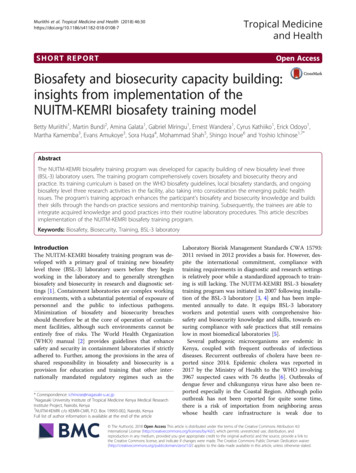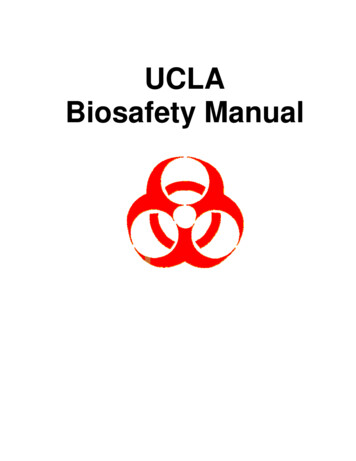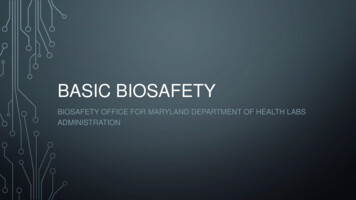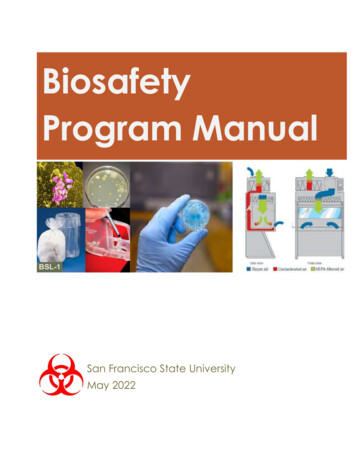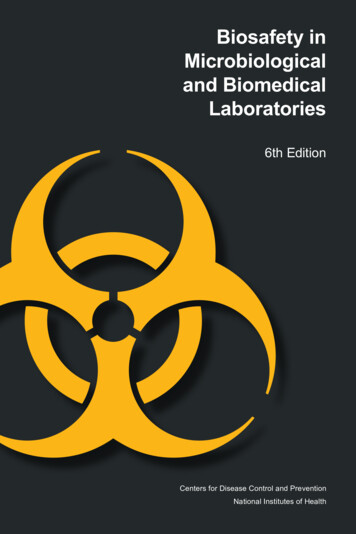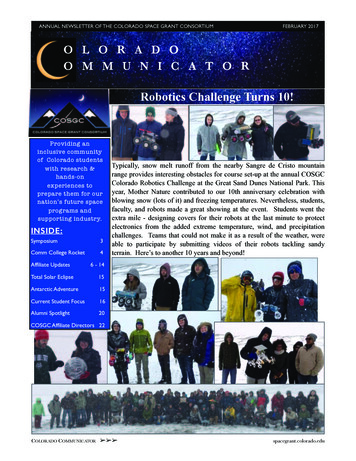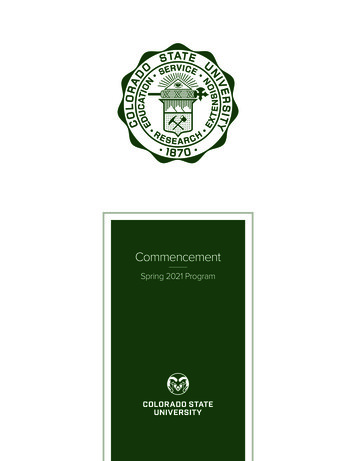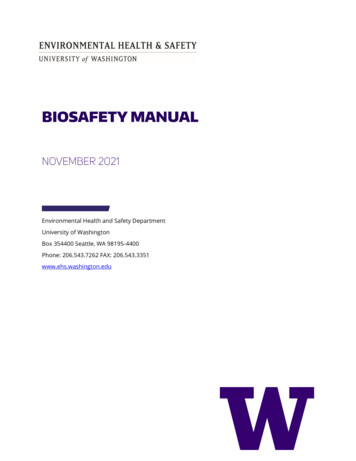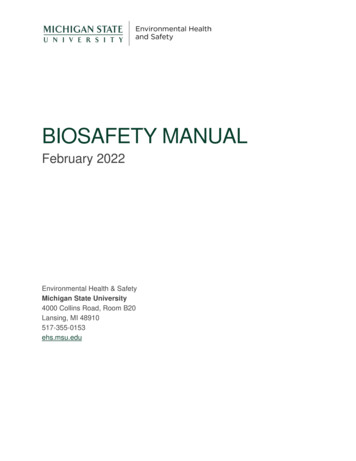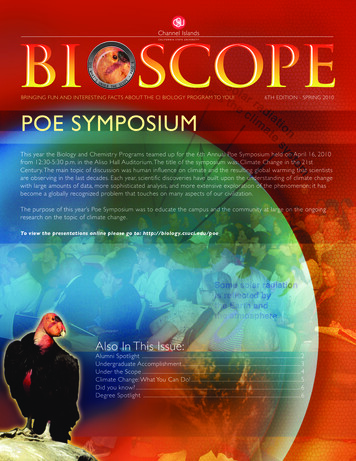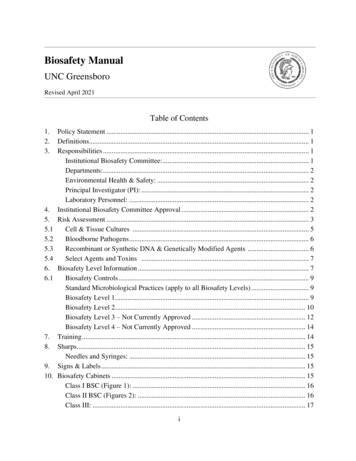![Biosafety Manual University Of Colorado Boulder 120621[80]](/img/25/biosafety-manual-university-of-colorado-boulder.jpg)
Transcription
UNIVERSITY OF COLORADO BOULDERBIOSAFETY MANUALPage 1 of 43
Table of ContentsOffice and Personnel Notification Numbers 4Purpose .5Instructions .5Principles of Biosafety/Biosafety Levels .6General Elements of Containment .6Laboratory Practices and Techniques .6Safety Equipment .7Facility Design .7Risk Assessment .8Agent Hazards .8Hazardous Characteristics of Laboratory Procedures .8Potential Hazards Associated with Work Practices, Safety Equipment and FacilitySafeguards .8The University of Colorado Institutional Biosafety Committee (IBC) .10Recombinant or Synthetic Nucleic Acid Molecule Research .11Reporting requirements for Incidents Involving Recombinant or Synthetic NucleicAcids, Violations of the NIH Guidelines, or Other Significant Research RelatedAccidents .12What Types of Incidents Must be Reported to NIH OSP .12Reporting Procedure at the University of Colorado Boulder .13Bloodborne Pathogens .14Select Agents .14Lentiviral Vectors 14Policies and Procedures .15Biosafety Level 1 (BSL-1) .15Page 2 of 43
Animal Biosafety Level 1 (ABSL-1) .18Biosafety Level 2 (BSL-2) .24Animal Biosafety Level 2 (ABSL-2) .26Diagnostic Work-What to do if you Culture a BSL-3 Organism .30Biosafety Cabinets .31Biological Spills and Exposures .34Disposal of Biohazardous Waste 36Autoclaves .36Sharps Disposal . 38Transporting Biological Materials on Campus .40Shipping of Biological Materials to an Off Campus Destination .40Security 43Required Training .43Page 3 of 43
OFFICE AND PERSONNEL NOTIFICATION NUMBERSOfficeDepartmentPersonnelPrincipal InvestigatorPhone NumberOffice:Lab:Home:DepartmentLaboratory ManagerLab/Office:Home:EH&SMain Office303-492-6025303-492-6666After hours (they will contactBiosafety Group)Cher MasiniOffice:303-492-2817Biosafety OfficerTheresa SiefkasOffice:303-492-7072Assistant Biosafety Page 4 of 4324- Hour Service DeskFIRE911UCB /BOULDERPOLICE911AMBULANCE911UCB -5522
PurposeThis manual provides biosafety guidelines for those working at The University of Colorado Boulder(UCB), including any work that involves the handling of:1. biohazardous materials2. recombinant or synthetic nucleic acid molecules (rsNA)3. human or animal fluids, tissues, or cell linesThis biosafety manual has been developed by the biosafety group in Environmental Health andSafety at CU Boulder. The manual is part of UCB’s biosafety program established to accomplish thefollowing goals:1. protect personnel from exposure to infectious agents2. prevent environmental contamination3. provide an environment for high quality research while maintaining a safe workplace4. comply with applicable federal, state, and local requirementsThe biosafety manual provides university-wide safety guidelines, policies, and procedures for the useand manipulation of biohazards. Although the implementation of these procedures is the responsibilityof the Principal Investigator (PI), its success depends largely on the combined efforts of the laboratorysupervisors and employees. Planning for and implementation of biological safety must be a part ofevery laboratory activity in which biohazardous materials are used.In general, the handling and manipulation of biological agents and toxins, as well as recombinant orsynthetic nucleic acid molecules, requires the use of various precautionary measures depending onthe material(s) involved. This manual will provide assistance in the evaluation, containment andcontrol of biohazards. However, it is imperative that all parties involved or working with thesematerials seek additional advice and training when necessary.InstructionsThis manual may be maintained as an electronic document or printed off as a hard copy for use inyour laboratory. The Biosafety Group in EH&S will be responsible for updating the manual on-lineperiodically to reflect changes in relevant guidelines, regulations, and policies as they occur.Researchers will be notified when those changes have been made.Suggestions for researcher generated documents that should be added to this manual to enhance itsusefulness are:1. PDF of current biological registration (IBC application) from BioRAFT2. Standard Operating Procedures for:a. Decontaminating laboratory surfacesb. Addressing spills of biological materialsc. Biosafety cabinet operationd. Autoclave operatione. Specialized equipment operation and maintenance unique to the researchf. Post-exposure procedures5
Principles of Biosafety/Biosafety LevelsGeneral Elements of ContainmentBiosafety in Microbiological and Biomedical Laboratories (BMBL) 1, published by the United StatesDepartment of Health and Human Services, is the definitive reference on biosafety and should beread and followed by all CU Boulder personnel working with potentially infectious agents. Thispublication can be accessed on the Centers for Disease Control and Prevention (CDC) website.Biosafety in Microbiological and Biomedical Laboratories—6th Edition (cdc.gov)Central to any discussion involving biosafety is the concept of containment of infectious agents toprevent contamination of the worker, nearby workers, or the environment. Containment is also utilizedto prevent contamination of research samples or animals. There are three general elements ofcontainment:1) Laboratory practices and techniques2) Safety equipment3) Facility designEach of these will be discussed briefly – for more detail, see the section on Principals of Biosafety inthe BMBL.Laboratory Practices and TechniquesStrict adherence to standard microbiological practices and techniques is essential for successfulcontainment. Most exposures and subsequent infections occur while performing routine proceduresand techniques.Every manipulation of a biological sample has the potential for releasing a portion of the sample inmicrodroplet form to the air and work surfaces. One way to view the potential for release of biologicalagents from a given sample is to consider the amount of energy that is used to manipulate thesample. High-energy techniques (i.e. homogenization) have the potential to release aerosols of thesample if not properly contained. However, even low energy procedures such as removing screwcaps and pouring or stirring of liquid medium can release aerosols of the sample. Other examples ofprocedures that can generate aerosolized biohazards include:Washing down animal roomsLaboratory dishwashingTransferring tissue culture mediaCentrifugationSeparating blood serumAerosols have the potential to contaminate work surfaces, exposed skin and garments, and air in thebreathing zone. Therefore, aerosols can result in topical, oral, and respiratory exposures for workers.6
Personal hygiene practices provide the simplest yet most important means for preventing diseasetransmission. This is especially true for workers who directly handle animals or animal tissues/bodyfluids. Practices such as routine hand washing at each available opportunity can be very successful inpreventing contamination of more susceptible regions of the body, as well as inanimate surfaces.Specifics on standard microbiological practices and techniques are discussed in more detail in the“Standard Biosafety Practices” section in the BMBL and in Prudent Practices in the Laboratory:Handling and Management of Chemical Hazards. Development of, and adherence to, standardmicrobiological practices is fundamental to the practice of biosafety. Safety equipment and laboratorydesign cannot be counted on to compensate for a lack of these practices.Safety EquipmentSafety equipment includes safety centrifuge cups, biological safety cabinet (BSC’s) and enclosedcontainers. Safety equipment also includes personal protective equipment (PPE) such as gloves, labcoats or gowns, respirators, safety glasses and goggles. Safety equipment is often referred to as aprimary barrier, since it generally represents the initial barrier(s) of protections downstream from thepotential hazard.Combinations of various types of safety equipment can be used to create more than one primarybarrier. However, circumstances may make it impractical to use equipment such as BSC’s orcompletely enclosed containers, leaving PPE as the only primary barrier between the worker and asample containing an infectious agent. This again illustrates the importance of standardmicrobiological practices because of the potential for PPE or other safety equipment failure. The useof safety equipment is discussed further in the BMBL.Facility DesignThe design of a facility used to conduct research involving specific biological agents is highlydependent on the epidemiology and the risk and route of transmission associated with those agents.Facility design is viewed as a secondary barrier to protect workers, both inside and outside thefacility. These secondary barriers may include separation of the laboratory work area from publicaccess, hand washing facilities, specialized ventilation systems to assure directional airflow, airtreatment systems to decontaminate or remove agents from exhaust air or controlled / restrictedaccess zones. More information on design criteria for specific agents and biosafety levels is found inthe BMBL.As risk of transmission increases, the number of requirements for facility design also increases.Evaluation of risk associated with a given human pathogen is a highly subjective task. Theepidemiology and etiology associated with a specific human pathogen may be a steadily evolvingcourse of events. Thus, facility design should not be viewed as a substitute for standardmicrobiological practices. To minimize risk of transmission, the first aspect to consider is engineeringcontrols, followed by administrative controls. The last route of protections should be wearing of PPE.7
Risk AssessmentRisk assessment is a process used to examine the various factors associated with a procedureinvolving biological materials in order to identify the hazardous characteristics of the material, theactivities that can result in an exposure to an infectious agent, the likelihood that exposure will causea laboratory acquired infection, and the probable consequences of an infection. The informationidentified by risk assessment will provide a guide for the selection of biosafety levels, microbiologicalpractices, safety equipment, and facility safeguards that can prevent laboratory acquired infectionsand reduce the risk of environmental contamination. Factors to consider in a risk assessment includeboth agent hazards and laboratory procedure factors.Agent Hazards:1.2.3.4.Capability to infect and cause disease in a susceptible hostVirulence as measured by the severity of diseaseAvailability of preventive measures and effective treatments for the diseaseProbable routes of transmission of laboratory infection:a) mucous membrane exposureb) parenteral injectionc) ingestiond) inhalatione) dermal5. Infective dose6. Stability in the environment7. Host range8. Its endemic nature9. Confirmed reports of laboratory acquired infections10. Origin of the agentHazardous Characteristics of Laboratory Procedures:1.2.3.4.Procedures and operations that generate aerosolsAgent concentration and suspension volumeUse of sharpsProcedures that involve animalsa) Bites and scratchesb) Exposure to zoonotic agents5. Complexity of a laboratory procedurePotential Hazards Associated with Work Practices, Safety Equipment and Facility Safeguards:1. Potential deficiencies in laboratory worker training and proficiency2. Inadequate training in the selection and use of personal protective equipment3. Safety equipment that does not work properly4. Inadequate training on the proper use and operation of safety equipment5. Loss of directional airflow and integrity of the facility’s HVAC system8
Biological risk assessment is a subjective process that requires careful consideration of the potentialhazards associated with the biological agents, laboratory procedures, and the facility itself. TheCenters for Disease Control and Prevention publication Biosafety in Microbiological and BiomedicalLaboratories (BMBL) describes a five-step approach to provide structure to the risk assessmentprocess.1. Identify hazards associated with the agent and perform an initial assessment of risk.2. Identify laboratory procedure hazards.3. Make a determination of the appropriate biosafety level and incorporate additional precautionsindicated by the risk assessment. (Determination of appropriate biosafety level should be donein consultation with biosafety professional)4. Evaluate the proficiencies of staff regarding safe practices and the integrity of safetyequipment.5. Review the risk assessment with a biosafety professional, subject matter expert and theInstitutional Biosafety Committee (IBC).Any new knowledge and experience may justify re-examining the risk assessment and thesafeguards that were put in place. Risk assessment must be the basis for any recommended change.9
The University of Colorado Institutional Biosafety Committee (IBC)The Institutional Biosafety Committee (IBC) is responsible for reviewing all University research andteaching activities involving the use of biohazards, recombinant or synthetic nucleic acid molecules,select agents, or bloodborne pathogens whether the activities are carried out on campus or offcampus (usually under other Institutional Biosafety Committees at other institutions).Most biological research requires IBC authorization prior to initiation. This authorization mustbe renewed every 3 years.The IBC meets regularly and will review and authorize research involving: any biological agents,infected animals or tissues (including fieldwork), recombinant or synthetic nucleic acid molecules,select agents and toxins, and work with human blood, bodily fluids, tissues or cells in culture.Researchers can complete the biological registration in BioRAFT and submit it to the AssistantBiosafety Officer or the Biosafety Officer for pre-review. If there are corrections to be made or if theapplication needs to have more information added for clarification, the application will be returned tothe researcher for modification. The completed biological registration is then sent to a designatedmember for review and presentation during the next scheduled IBC meeting. Researchers are notifiedof the results of the IBC review. Once the biological registration has been approved and personnellisted on the protocol have successfully completed the appropriate training, the letter of approval willbe sent to the Principal Investigator.Every researcher who submits a biological registration must also have a Biosafety LabInspection/Audit completed. The Biosafety Lab inspections/audits are coordinated through theEnvironmental Health and Safety biosafety group. The Biosafety Lab Inspection process addressesseveral key laboratory safety issues including contamination control, inventory control, biosafetytraining, engineering controls, administrative controls, containment, and other pertinent elements oflaboratory safety. A copy of the Laboratory Biosafety Checklist is available ratory-audit-checklist/. Biosafety Lab inspections areconducted on an annual basis.10
Recombinant or Synthetic Nucleic Acid Molecule ResearchAs a condition for funding of recombinant or synthetic nucleic acid molecule research, UCB mustensure that research conducted at or sponsored by UCB, irrespective of the source of funding,complies with the most current National Institutes of Health (NIH) Guidelines for Research InvolvingRecombinant or Synthetic Nucleic Acid Molecules es/biosafety/nih-guidelines. At UCB, the responsibility for ensuring that recombinant orsynthetic nucleic acid molecule activities comply with all applicable guidelines rests with the institutionand the Institutional Biosafety Committee (IBC) acting on its behalf.Before experiments involving recombinant or synthetic nucleic acid molecule research can begin atUCB, the Principal Investigator (PI) must submit an IBC Biological Registration in BioRaft:https://colorado.bioraft.com/. A PI Quick Start Guide can be requested from the Biosafety Office(ehsbio@colorado.edu).All recombinant DNA research proposals require the PI to make an initial determination of therequired level of physical and biological containment. For that reason, the NIH has developed sixcategories (III-A to III-F) addressing different types of rDNA research.If the proposed research falls within section III-A of the NIH Guidelines, the experiment isconsidered a "Major Action". This includes experiments involving human gene transferexperiments. As a result, the experiment cannot be initiated without submission of relevantinformation to the Office of Science Policy (OSP) at the NIH. In addition, the proposal has tobe published in the Federal Register for 15 days, it needs to be reviewed by the Recombinant DNAAdvisory Committee (RAC), and specific approval by the NIH has to be obtained. The containmentconditions for such an experiment will be recommended by the RAC and set by the NIH at the time ofapproval. The proposal requires IBC approval before initiation.If the proposed research falls within section III-B, the research cannot be initiated withoutsubmission of relevant information on the proposed experiment to NIH/OSP (For exceptions seethe NIH guidelines). Experiments covered in III-B include the cloning of toxic molecules. Thecontainment conditions for such experiments will be determined by NIH/OSP in consultationwith ad hoc experts. Such experiments require Institutional Biosafety Committee approval beforeinitiation. Please refer to the guidelines for more specifics.In section III-C, experiments with human subjects are covered. These experiments require IBC andIRB (Institutional Review Board) approval and NIH/OSP registration before initiation.Section III-D, the next category, covers whole animal or plant experiments as well as projectsinvolving DNA from Risk Group 2, 3 or 4 agents. Prior to the initiation of an experiment that fallsinto Section III-D, the PI must submit a biological registration to the IBC. The IBC reviews andapproves all experiments in this category prior to their initiation.Section III-E experiments require that the filing of a biological registration with the IBC at the time theexperiment is initiated. The IBC reviews and approves all such proposals, but IBC review andapproval prior to initiation of the experiment is not required.Section III-F experiments are exempt from the NIH Guidelines but a registration with the UCB IBC isstill required.11
For much more detailed and thorough information on the requirements for conducting researchinvolving recombinant or synthetic nucleic acid molecules please refer to the National Institutes ofHealth (NIH) Guidelines for Research Involving Recombinant or Synthetic Nucleic Acid y-activities/biosafety/nih-guidelines.Reporting Requirements for Incidents Involving Recombinant or Synthetic Nucleic Acids,Violations of the NIH Guidelines, or other Significant Research Related AccidentsThe NIH Guidelines for Research Involving Recombinant or Synthetic Nucleic Acid Molecules statesthat any significant problems, violations of the NIH Guidelines, or any significant research relatedaccidents, exposures and/or illnesses must be reported to the NIH Office of Science Policy (OSP)within 30 days. Certain types of incidents must be reported sooner. Spills or accidents in BSL-2laboratories that result in an overt exposure must be reported to NIH OSP immediately.What Types of Incidents Must be Reported to NIH OSP?Any spill or accident involving recombinant or synthetic nucleic acid molecules that occurs in BSL-2laboratories or higher, leads to a personal injury or illness, or results in a breach of containment mustbe reported to NIH OSP. Examples of such incidents are:1.2.3.4.Skin punctures with needles containing recombinant or synthetic nucleic acid moleculesThe escape or improper disposition of a transgenic animalSpills of high-risk recombinant or synthetic nucleic acids outside of a biosafety cabinetFailure to adhere to containment requirements and appropriate biosafety practices as outlinedin the NIH Guidelines must be reported to NIH OSP.Minor spills of low-risk agents that do not involve a breach of containment and were properlydecontaminated and disposed of normally do no need to be reported.If there is any doubt about whether an incident should be reported please contact theEnvironmental Health and Safety Office Biological Safety Group at 303-492-6025. NIH OSPshould be consulted if the IBC, investigator, or other institutional staff are uncertain whether anincident should be reported.12
Reporting Procedure at the University of Colorado Boulder1.Incidents that occur at the University of Colorado that involve recombinant or synthetic nucleicacid molecules, incidents that result in an overt exposure to materials containing recombinantor synthetic nucleic acids or any risk group 2 agent in a BSL-2/ABSL-2 laboratory must bereported to the University of Colorado Biosafety group 303-492-6025.2.The Biosafety Officer or the Assistant Biosafety Officer will work with the Primary Investigatorto gather the details of the incident to decide if the incident does need to be reported to NIHOSP, and if deemed necessary, consult with NIH OSP to determine if the incident warrants areport.3.If a report is deemed necessary, the Biosafety Officer or Assistant Biosafety Officer will workwith the Principal Investigator to complete the report. The report should contain sufficientinformation to explain the nature and consequences of the incident as well as the cause. Thereport should also include the measures that were taken to mitigate the problem and to preventa similar incident from happening again. An incident reporting template and additionalinformation is available from NIH OSP to facilitate the reporting ent-reporting/.4.The Biosafety Officer or Assistant Biosafety Officer shall inform the IBC and InstitutionalOfficial of the incident and provide a copy of the report for review.5.NIH OSP may require other information be provided such asa. A copy of the IBC meeting minutes documenting approval of the relevant protocol forthe research laboratory in which the incident occurred.b. A copy of the IBC minutes documenting that the incident was reviewed.c. Policies that were in place at the time the incident occurred.d. Revised policies or procedures that were prepared in response to the incident.e. Training records for the personnel who were involved in the incident.6.The Biosafety Officer or Assistant Biosafety Officer shall submit the written report to NIH OSP.13
Bloodborne PathogensThe University of Colorado has adopted the Occupational Safety and Health Administration (OSHA)1910.1030 OSHA Bloodborne Pathogen Standard to protect workers who may be exposed to bloodfrom microorganisms that can cause disease in humans. Such pathogens include the hepatitis B virus(HBV), hepatitis C virus and the human immunodeficiency virus (HIV).Select AgentsInfectious agents and toxins that are considered by the Department of Health and Human Services(DHHS) or the United States Department of Agriculture (USDA) as having the potential to posesubstantial harm or a severe threat to human, animal, or plant health or plant products are regulatedas “select agents”.Select agents in any quantity are not permissible at CU Boulder. Toxins are permissible when inexempt quantities only. If you would like to work with toxins in exempt quantities, please contact theBiosafety Group at Environmental Health and Safety. Information regarding the Federal Select AgentProgram can be found at:Select Agent Website: http://www.selectagents.gov/Select Agents and Toxins List: ist.htmlPermissible Toxin Amounts: s.htmlLentiviral VectorsThe use of lentiviral vectors has been increasing because the vector system has attractive features;however, such research also raises biosafety concerns. The NIH Office of Biotechnology Activities(now the Office of Science Policy) received frequent questions regarding the appropriate containmentfor lentiviral vectors, particularly those derived from HIV-1. Because the NIH Guidelines for ResearchInvolving Recombinant or Synthetic Nucleic Acid Molecules (NIH Guidelines) do not explicitly addresscontainment for research with lentiviral vectors, the RAC was asked to provide additional guidance forinstitutional biosafety committees (IBCs) and investigators on how to conduct a risk assessment forlentiviral vector research. These guidelines are provided here: https://osp.od.nih.gov/wpcontent/uploads/Lenti Containment Guidance.pdf and additional training on lentiviral vectors isavailable: 16 .14
POLICIES AND PROCEDURESThe information provided in this document has been taken, in part from the CDC-NIH publication,“Biosafety in Microbiological and Biomedical Laboratories”, (BMBL) (6th Edition, June 2020); “NIHGuideline for Research Involving Recombinant or Synthetic Nucleic Acids Molecules” (NIHGuidelines) (April, 2019). Information from the University of Colorado Boulder Environmental Healthand Safety Hazardous Waste Generators’ Guide, Laboratory Safety Guidelines and other pertinentstate, local and federal guidelines and regulations have also been incorporated into this document.The table below provides a brief summary of the four biosafety levels, relative health risk associatedwith each level and some examples of microorganisms classified at each level.BSLDescriptionHealth Risk1Not known to consistentlycause disease in healthy adultsLow individualrisk, lowcommunity risk23*4*Associated with humandisease. Treatment and/orvaccine are often availableModerateindividual risk,low communityriskAgents associated with seriousor lethal human disease.Preventative or therapeuticinterventions may be availableAgents likely to cause seriousor lethal human disease forwhich preventative ortherapeutic interventions arenot usually availableHigh individualrisk, lowcommunity riskHigh individualrisk, highcommunity riskExamples E. coli K12Bacillus subtilis Salmonella sp.MRSAE. coli O157Human, nonhuman primatebodily tissuesor fluids,including celllines Yersinia pestisMycobacteriumtuberculosisSARS-CoV-2 EbolaMarburg Virus*Agents requiring BSL-3 and BSL-4 facilities and practices are not permitted at CU Boulder.Biosafety Level 1 (BSL-1)Biosafety Level 1 is suitable for work involving well-characterized agents not known to consistentlycause disease in immunocompetent adult humans, and present minimal potential hazard tolaboratory personnel and the environment. BSL-1 laboratories are not necessarily separated from thegeneral traffic patterns in the building. Work is typically conducted on open bench tops using standardmicrobiological practices. Special containment equipment or facility design is not required but may beused as determined by appropriate risk assessment. Laboratory personnel must have specific trainingin the procedures conducted in the laboratory and must be supervised by a scientist with training inmicrobiology or a related science.The following standard practices, safety equipment, and facility requirements apply to BSL-1.15
A.Standard Microbiological Practices1.The laboratory supervisor must enforce the departmental policies that control access tothe laboratory.2.Persons must wash their hands after working with all potentially hazardous materialsincluding recombinant or synthetic nucleic acids, potentially infectious materials,chemicals etc., before leaving the laboratory.3.Eating, drinking, smoking, handling contact lenses, applying cosmetics, and storing foodfor human consumption must not be permitted in laboratory areas. Food must be storedoutside the laboratory area in cabinets or refrigerators designated and used for thispurpose. Please refer to the UCB Eating, Drinking, and Related Activities Policy formore information: related-activitieslaboratories .4.Mouth pipetting is prohibited; mechanical pipetting devices must be used.5.Policies for the safe handling of sharps, such as needles, scalpels, pipettes, and brokenglassware must be developed and implemented. UCB Policies are available metal-sharpsWhenever practical, laboratory supervisors should adopt improved engineering andwork practice controls that reduce risk of sharps injuries. Precautions, including thoselisted below, must always be taken with sharp items. These include:a.Careful management of needles and other sharps are of primary imp
Centers for Disease Control and Prevention publication Biosafety in Microbiological and Biomedical Laboratories (BMBL) describes a five-step approach to provide structure to the risk assessment process. 1. Identify hazards associated with the agent and perform an initial assessment of risk. 2. Identify laboratory procedure hazards. 3.
